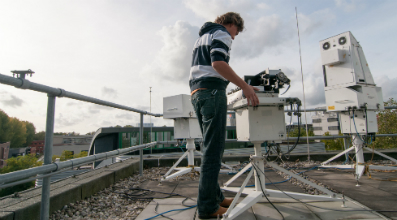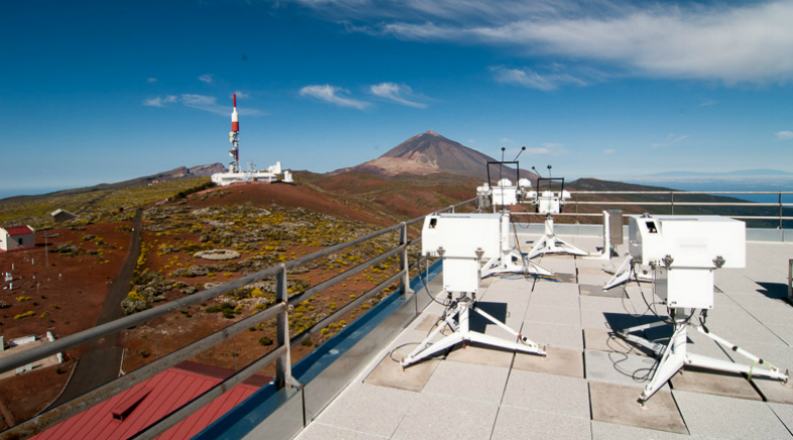Work at the factory in Delft
When I’m at the Kipp & Zonen office in Delft, The Netherlands, my day always starts with answering questions from our clients worldwide – assisting them with their problems and questions regarding the whole Brewer family of instruments. After all the e-mails have been answered, I focus on the tasks we have in the office. This can be a range of activities.
Customer Brewer services
Clients from all over the world send their Brewer in for service, maintenance, repair or calibration. Before shipment, we always ask for recent data files from the Brewer and we examine these so that we have a good idea of the state of the Brewer in advance. This enables us to advise the customer of what work may be needed to get their Brewer into optimal operational condition again. Of course, it has to be kept in mind that not everything is visible in the data files, so sometimes when the Brewer arrives in Delft the job at hand is bigger than anticipated.
Remote assistance
Because Brewers operate 24/7 connected to a computer it is possible to get remote access though desktop sharing, such as with TeamViewer. This allows us to take control of the Brewer and its software to run tests, review data files and diagnose possible problems or maintenance issues.
Sometimes clients have a big project on hand and we are able to help them achieve their goals. Recently, an Italian customer wanted to physically move their Brewer over 500 kilometres. We first performed a remote health check of the Brewer and provided our customer with all the tips and tricks regarding packing and transportation. Installed on its new site, we once again performed a remote health check to see if the Brewer’s spectral response or other behaviour had changed during transportation. Luckily all was well and the relocation was a success!
A passion for precision
The alignment, testing and calibration of new Brewers also form a major part of my work. Since Kipp & Zonen builds Brewers from scratch, a huge number of tests need to be conducted to ensure a stable and precise instrument. Checking of parts from suppliers, electrical testing, optical alignment, mechanical optimization and durability tests are done over a period of around 3-4 months. Everything must be as close to perfect as possible.
 In the final phase, the Brewers are installed on the roof here in Delft, next to one of our reference instruments. When we are completely happy with the new Brewer and all the tests are well within the factory limits, we perform an Ozone and Ultraviolet (UV) calibration. After a final inspection and careful packing, the Brewer is shipped to the customer.
In the final phase, the Brewers are installed on the roof here in Delft, next to one of our reference instruments. When we are completely happy with the new Brewer and all the tests are well within the factory limits, we perform an Ozone and Ultraviolet (UV) calibration. After a final inspection and careful packing, the Brewer is shipped to the customer.
Since the Brewer dates back to 1981, improvements and checks on the hardware need to be done regularly. This is mainly due to the fact of obsolete components, but also unexpected changes in external component fabrication need to be carefully monitored to maintain a highly precise and reliable instrument. Kipp & Zonen recently invested quite some effort in redesigning the main electronics board and lamp control board (see http://kippzonen-brewer.com/news/new-lampboard/ for more details) and recently announced a new and better UV stability kit. So, as you can see, development never stops on the Brewer!
Travelling the world
Personally, this is my absolute favourite part of the job: traveling the world to help customers with their Brewers. Brewers are often installed in remote places that provide astonishing and breath-taking views. I will never forget the amazing view from the top of the Atmospheric Observatory at Izaña, Tenerife. Sodankylä, in the north of Finland, Abu Dhabi in the Middle East and Seoul in South Korea also made a lasting impression on me.
Installation and training on the spot
Since transporting a Brewer always has a risk of alignment changes due to shocks in handling, a newly delivered Brewer will always be installed and commissioned by a Kipp & Zonen Brewer Engineer. To ensure reliability, many of the factory tests are repeated after installation to ensure that the state of the Brewer is the same as it was in the factory in Delft prior to shipment. A full spectral scan, together with a UV stability kit check and sun measurements confirm this.
The on-site installation and commissioning is always a very good time to train and educate new Brewer operators and to refresh and update the Brewer operation procedures with existing users. We see a trend now with Institutes and Observatories wishing to have a MkIII double spectrometer Brewer to run alongside, or replace, an existing MkII or MkIV single spectrometer instrument. This is largely because of the much better spectral UV measurement capability of the MkIII. In this case, we provide training that emphasizes the differences between the types of instruments. Recent examples of this are at Gánovce, Slovakia and Cahersiveen, Ireland.
On-site service and calibration
Kipp & Zonen also provides on-site calibration and servicing for Brewer users around the world. This involves shipping our ‘Travelling Standard’ MkIII Brewer #158 and our traceable UV calibration equipment. Once it has arrived, a Kipp & Zonen Brewer Engineer arrives to unpack and install it all, service and optimise the customer Brewer(s), carry out the Ozone and UV calibrations; and then pack it all up again for shipment back to Delft.
This sounds fairly straightforward. However, the time period when we can make a reliable Ozone calibration depends on the latitude of the site (the sun must be high enough) and the weather conditions. We need 2-3 days of clear sun observations, so there is no point going in the monsoon season or when there are a lot of forest fires, or a volcanic eruption in the region!
Inter-comparisons of Brewers
The Regional Brewer Calibration Center for Europe (RBBC-E) is based in Izaña, Tenerife and has a reference ‘triad’ of MkIII Brewers. Every year RBBC-E organises an inter-comparison to which participants bring their Brewers to be compared against one of the reference instruments. The location alternates between Arosa in Switzerland and Huelva in Spain. As the manufacturer, Kipp & Zonen also participates, to provide service and maintenance to the visiting instruments and to calibrate our own reference Brewers.
So, as you can see, every day can, and will, be different for a Brewer Engineer! Time to go now, I have an airplane to catch …..

Photo taken by Alexander at the Regional Brewer Calibration Center for Europe (RBBC-E) based in Izaña, AEMET - Meteorological State Agency, Spain